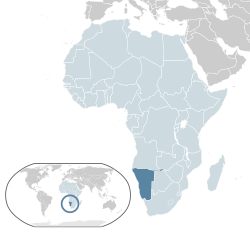Namibie
Coordinates: 22°S 17°E / 22°S 17°E
Namibie, offeecially the Republic o Namibie is a kintra in sooth wast Africae on the Atlantic coast. It haes mairches wi Angola, Zambia, an Zimbabwe tae the north, Botswana tae the east an Sooth Africae tae the sooth. It wis unthirled frae Sooth Africae 1990. Afore that, it wis cried Sooth West Africae. Its caipital is cried Windhoek. Tourism an diamant minin is verra important tae the Namibian economy.
Republic o Namibie | |
|---|---|
Motto: "Unity, Leeberty, Juistice" | |
 Location o Namibie (dark blue) – in Africae (light blue & dark grey) | |
| Caipital and largest city | Windhoek 22°34.2′S 17°5.167′E / 22.5700°S 17.086117°E |
| Offeecial leids | Inglis |
| Recognised naitional leids | Afrikaans, German, Otjiherero, Khoekhoe, Oshiwambo, Kwangali, Setswana, Silozi[9] |
| Recognised regional leids | Ju'hoansi, Rumanyo, Thimbukushu |
| Ethnic groups (2014) | |
| Demonym(s) | Namibian |
| Govrenment | Unitar dominant-pairty semi-presidential republic[10][11] |
• Preses | Nangolo Mbumba |
| Netumbo Nandi-Ndaitwah | |
| Saara Kuugongelwa-Amadhila | |
• Depute Prime Meenister | vacant |
| Legislatur | Pairlament |
| Naitional Cooncil[12] | |
| Naitional Assemmly | |
| Unthirldom frae Sooth Africae | |
| 9 Februar 1990 | |
• Unthirldom | 21 Mairch 1990 |
| Aurie | |
• Total | 825,615 km2 (318,772 sq mi) (34t) |
• Water (%) | negligible |
| Population | |
• 2017 census | 2,606,971[13] |
• Density | 3.2/km2 (8.3/sq mi) (235t) |
| GDP (PPP) | 2017 estimate |
• Total | $27.451 billion[14] |
• Per capita | $11,838[14] |
| GDP (nominal) | 2017 estimate |
• Tot | $11.765 billion[14] |
• Per capita | $5,073[14] |
| Gini (2009) | 59.7[15] heich |
| HDI (2015) | medium · 125t |
| Currency | Namibie dollar (NAD), Sooth African rand (ZAR) |
| Time zone | UTC+2 (CAT) |
| Drivin side | caur |
| Cawin code | +264 |
| ISO 3166 code | NA |
| Internet TLD | .na |

Afore Warld War I Namibie wis a German colony. German is still widely spake in the kintra, thou Inglis is the offeecial leid.
References
eedit- ↑ "Communal Land Reform Act, Afrikaans" (PDF). Government of Namibia. Archived frae the original (PDF) on 25 Februar 2016. Retrieved 18 Februar 2016.
- ↑ "Communal Land Reform Act, German" (PDF). Government of Namibia. Retrieved 18 Februar 2016.[deid airtin]
- ↑ "Communal Land Reform Act, Khoekhoegowab" (PDF). Government of Namibia. Archived frae the original (PDF) on 25 Februar 2016. Retrieved 18 Februar 2016.
- ↑ "Communal Land Reform Act, Otjiherero" (PDF). Government of Namibia. Retrieved 18 Februar 2016.[deid airtin]
- ↑ "Communal Land Reform Act, Oshiwambo" (PDF). Government of Namibia. Archived frae the original (PDF) on 1 Mairch 2016. Retrieved 18 Februar 2016.
- ↑ "Communal Land Reform Act, Rukwangali" (PDF). Government of Namibia. Archived frae the original (PDF) on 25 Februar 2016. Retrieved 18 Februar 2016.
- ↑ "Communal Land Reform Act, Setswana" (PDF). Government of Namibia. Archived frae the original (PDF) on 25 Februar 2016. Retrieved 18 Februar 2016.
- ↑ "Communal Land Reform Act, Lozi" (PDF). Government of Namibia. Archived frae the original (PDF) on 25 Februar 2016. Retrieved 18 Februar 2016.
- ↑ "CIA World Factbook". Central Intelligence Agency, US. Archived frae the original on 7 Mairch 2014. Retrieved 21 Februar 2016.
- ↑ Shugart, Matthew Søberg (September 2005). "Semi-Presidential Systems: Dual Executive and Mixed Authority Patterns" (PDF). Graduate School of International Relations and Pacific Studies. United States: University of California, San Diego. Archived frae the original (PDF) on 19 August 2008. Retrieved 4 September 2016. Cite has empty unkent parameter:
|dead-url=(help) "Archived copy" (PDF). Archived frae the original (PDF) on 19 August 2008. Retrieved 9 Februar 2018.CS1 maint: archived copy as title (link) - ↑ Shugart, Matthew Søberg (December 2005). "Semi-Presidential Systems: Dual Executive And Mixed Authority Patterns" (PDF). French Politics. Palgrave Macmillan Journals. 3 (3): pp. 323–351. doi:10.1057/palgrave.fp.8200087. Retrieved 4 September 2016.
Of the contemporary cases, only four provide the assembly majority an unrestricted right to vote no confidence, and of these, only two allow the president unrestricted authority to appoint the prime minister. These two, Mozambique and Namibia, as well as the Weimar Republic, thus resemble most closely the structure of authority depicted in the right panel of Figure 3, whereby the dual accountability of the cabinet to both the president and the assembly is maximized. (...) Namibia allows the president to dissolve [the assembly] at any time but places a novel negative incentive on his exercise of the right: He must stand for a new election at the same time as the new assembly elections.
CS1 maint: extra text (link) - ↑ "National Council". Parliament.gov.na (in Spainish). Retrieved 26 August 2017.
- ↑ "CountryMeters – Namibia population". CountryMeters. Archived frae the original on 30 September 2017. Retrieved 7 Februar 2018. Unknown parameter
|deadurl=ignored (help)CS1 maint: BOT: original-url status unknown (link) - ↑ a b c d "Namibia". International Monetary Fund.
- ↑ "Economic Policy and Poverty Unit". UNDP Namibia. Archived frae the original on 2 December 2013. Retrieved 10 September 2013.
- ↑ "2016 Human Development Report" (PDF). United Nations Development Programme. 2016. Retrieved 21 Mairch 2017.
| Wikimedia Commons haes media relatit tae Namibia. |

